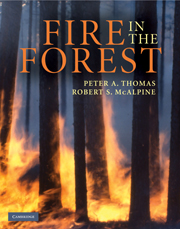Book contents
- Frontmatter
- Contents
- Preface
- List of contributors
- 1 In the beginning
- 2 Historical review
- 3 How a fire burns
- 4 Fire in the wild landscape
- 5 Fire ecology
- 6 The benefits of fire and its use as a landscape tool
- 7 Fire suppression
- 8 Wildland fire and its management – a look towards the future
- Further reading
- References used in the text
- Index
3 - How a fire burns
Published online by Cambridge University Press: 05 August 2012
- Frontmatter
- Contents
- Preface
- List of contributors
- 1 In the beginning
- 2 Historical review
- 3 How a fire burns
- 4 Fire in the wild landscape
- 5 Fire ecology
- 6 The benefits of fire and its use as a landscape tool
- 7 Fire suppression
- 8 Wildland fire and its management – a look towards the future
- Further reading
- References used in the text
- Index
Summary
Fire is a chemical reaction that results in the very rapid release of the energy stored in fuel. Plants use the sun's energy to combine carbon dioxide with water to produce carbon compounds (sugars, starch, cellulose etc.) and oxygen. When a plant dies and decomposes, the reverse happens: oxygen is used up in breaking apart the carbon compounds to release carbon dioxide, water and a gentle trickle of heat (think about the heat produced by a good rotting compost heap or pile of manure). Fire is a form of decomposition, just a lot quicker, releasing the carbon dioxide, water and heat in a massive burst. In this chapter we start at the beginning and look at how plant material burns before considering how a whole fire burns.
Mechanics of fire
When heat is applied to, for example, a piece of wood, three distinct phases are passed through: pre-ignition, ignition and then combustion.
Pre-ignition
When heat is first applied to our piece of wood, the energy will initially be absorbed by water contained in the wood (which has a large capacity to store heat). Then as the temperature rises further (Fig. 3.1a), the heat evaporates the water at the surface of the wood (it may even steam as the water vapour condenses in the air) which keeps the wood surface around 100 °C (see Box 3.1 for a demonstration of this).
- Type
- Chapter
- Information
- Fire in the Forest , pp. 26 - 53Publisher: Cambridge University PressPrint publication year: 2010



